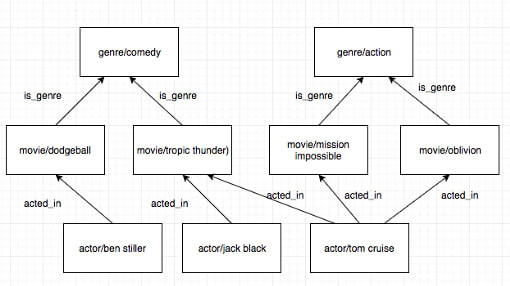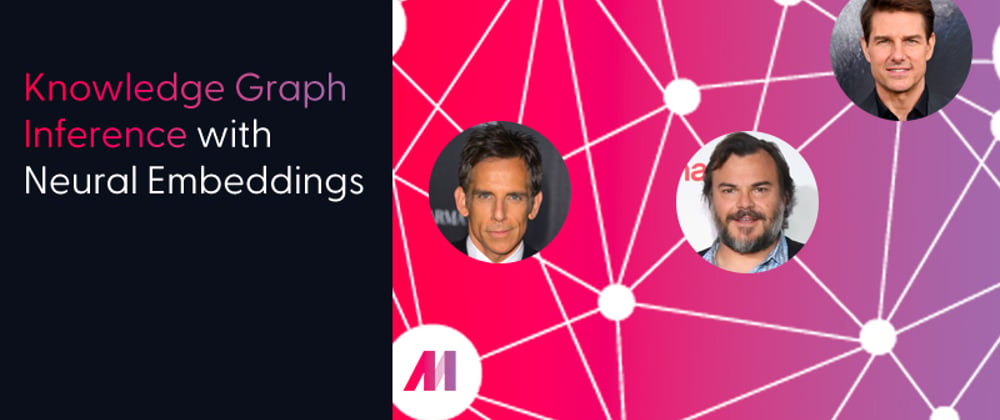Recently, some of my work involved working with knowledge graphs. I was somewhat surprised to discover how sparse resources were on working with knowledge graphs. Most of the literature was locked in research papers that are relatively inaccessible unless you have a fair amount of time on your hands.
What is a knowledge graph?
Simply put, a knowledge graph is a collection of facts, in the form of two entities and a relationship: (e1, r, e2). For instance, a representation of the concept that “Tom Cruise acted in Mission Impossible” would be represented as:
(“Tom Cruise”, 'acted_in', “Mission Impossible”)
 Photo credit: Mission Impossible
Photo credit: Mission Impossible
Here is an example knowledge graph that could represent movies, genres and actors:
 Knowledge graph of genres, movies, and actors
Knowledge graph of genres, movies, and actors
Link Inference
Now that we have a knowledge graph, we may want to augment the data, and predict new relationships that should exist. In the knowledge graph above, we encode relationships for genres to movies, and movies to actors. If you squint at the knowledge graph above you can plausibly imagine a model that is able to learn that actors generally star in the same genre of movies. Tom Cruise usually stars in action movies, and Ben Stiller usually stars in comedies.

Notice in the knowledge graph above, there should exist a link between Ben Stiller and Tropic Thunder. (Ben Stiller acted in Tropic Thunder). Also note that we should be able to infer the type of genre each of these actors tend to act in. Tom Cruise tends to act in action movies, while Jack Black and Ben Stiller tend to star in comedies. From this information, we should be able to infer that there is likely an 'acted_in' relationship between Ben Stiller and Tropic Thunder.
Learning
What learning algorithm can we use to infer this information? Recall how word embeddings are trained. We can apply a similar strategy here. We can create a vector embedding for each entity and each relationship type, and train the embeddings such that
![]()
We can imagine a suitable set of embeddings look like this:

In this case, the closest movie to the vector Ben Stiller + 'acted_in' is dodgeball, but the second closest is Tropic Thunder.
 Photo credit: Dodgeball
Photo credit: Dodgeball
As for training the model, we can try to maximize the difference between the score of of a relationship that doesn’t exist: for instance the relationship (Tom Cruise, is_genre, Ben Stiller) and a relationship that does: (Ben Stiller, 'acted_in', Dodgeball), referred to as negative sampling. This is also how word vectors are trained. Concretely:

Specifically, this encourages the positive score to be less than the negative score by some MARGIN amount. For instance a possible solution would be:
positive = 0
negative = MARGIN
loss = positive - negative + MARGIN = 0
Lets build it
I built this in PyTorch and posted the code here. However, I’ll point out some of the more interesting aspects of the implementation that I found to help make the training more stable.
Negative Sampling
The goal of negative sampling is to produce a fact that is incorrect. For instance (“Ben Stiller”, 'acted_in', “Oblivion”). My pseudo code is as follows
def generate_negative_sample():
while (entity_1, relation, entity_2) in graph:
entity_1 = random_entity()
relation = random_relation()
entity_2 = random_entity()
I found that learning was more stable when the negative samples were oversampled relative to the number of correct facts.
def train(fact, embedding_model, optimizer):
# Oversample negative entries
avg_loss = 0
for i in range(40):
embedding_model.zero_grad()
loss = embedding_model(fact)
loss.backward()
optimizer.step()
avg_loss += loss.data[0]
return avg_loss / 10
 Training loss
Training loss
Recall the goal of this model is to infer that Ben Stiller is more likely to have acted in Tropic Thunder over Mission Impossible or Oblivion. Here are the results (remember, according to our formulation, a lower score = more likely).
score(('ben stiller', 'acted_in', 'dodgeball')) = 1.5305
score(('ben stiller', 'acted_in', 'tropic thunder')) = 2.5801
score(('ben stiller', 'acted_in', 'mission impossible')) = 3.4038
score(('ben stiller', 'acted_in', 'oblivion')) = 3.3958
So, this model is able to figure out that Ben Stiller is likely to have acted in Tropic Thunder, a comedy, more so than action movies, and it was able to learn this by modeling over the links in the graph.
 Photo credit: Oblivion
Photo credit: Oblivion







Oldest comments (0)